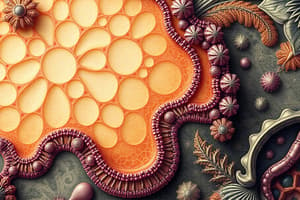Podcast
Questions and Answers
Which type of epithelial tissue is involved in secretory, absorptive, or excretory functions?
Which type of epithelial tissue is involved in secretory, absorptive, or excretory functions?
- Cuboidal Epithelium (correct)
- Simple Squamous
- Stratified Squamous
- Simple Columnar
What is the distinct arrangement of epithelial tissue called?
What is the distinct arrangement of epithelial tissue called?
- Blood
- Dense Regular Connective Tissue
- Areolar Connective Tissue
- Cuboidal Epithelium (correct)
Which type of epithelial tissue lines the outer surfaces of organs and blood vessels throughout the body?
Which type of epithelial tissue lines the outer surfaces of organs and blood vessels throughout the body?
- Simple Columnar
- Cuboidal Epithelium
- Simple Squamous (correct)
- Pseudostratified Columnar
What is the function of tight junctions in epithelial tissue?
What is the function of tight junctions in epithelial tissue?
Which type of connective tissue is characterized by closely joined cells with tight junctions?
Which type of connective tissue is characterized by closely joined cells with tight junctions?
Which type of connective tissue is characterized by closely joined cells with tight junctions?
Which type of connective tissue is characterized by closely joined cells with tight junctions?
Which type of connective tissue is composed of a gel-like matrix with fibroblasts and collagen fibers?
Which type of connective tissue is composed of a gel-like matrix with fibroblasts and collagen fibers?
Which type of epithelial tissue is involved in absorption and secretion?
Which type of epithelial tissue is involved in absorption and secretion?
What is the function of stratified squamous epithelium?
What is the function of stratified squamous epithelium?
What is the main function of pseudostratified columnar epithelium?
What is the main function of pseudostratified columnar epithelium?
Flashcards are hidden until you start studying
Study Notes
Epithelial Tissue Functions
- Secretory, Absorptive, or Excretory Functions: Epithelial tissue plays a critical role in secretion, absorption, and excretion due to its structural arrangement and specialized cells.
Epithelial Tissue Arrangement
- Distinct Arrangement: The distinct arrangement of epithelial tissue is referred to as polarity, meaning cells have an apical surface, a basal surface, and lateral surfaces. This structural organization underpins their diverse functional roles.
Epithelial Tissue Location
- Outer Surfaces of Organs and Blood Vessels: The outer surfaces of organs and blood vessels are lined by simple squamous epithelium. Its thin, flat cells facilitate diffusion and filtration processes.
Tight Junctions in Epithelial Tissue
- Tight Junctions: Tight junctions in epithelial tissue act as seals, preventing the leakage of fluids between cells. This is crucial for maintaining tissue integrity and controlling the movement of substances across epithelial barriers.
Connective Tissue Types
-
Closely Joined Cells with Tight Junctions: Epithelial tissues are characterized by closely joined cells with tight junctions.
-
Gel-like Matrix with Fibroblasts and Collagen Fibers: Loose connective tissue, also known as areolar connective tissue, exhibits a gel-like matrix rich in fibroblasts and collagen fibers. This flexible and adaptable tissue supports and binds other tissues.
Epithelial Tissue Types
- Absorption and Secretion: Simple cuboidal epithelium, with its cube-shaped cells, is primarily involved in absorption and secretion.
Epithelial Tissue Functions
-
Protection: Stratified squamous epithelium provides protection against abrasion, friction, and pathogens due to its layered structure.
-
Secretion and Movement: Pseudostratified columnar epithelium is responsible for secretion and the movement of substances, mainly due to the presence of cilia.
Studying That Suits You
Use AI to generate personalized quizzes and flashcards to suit your learning preferences.




